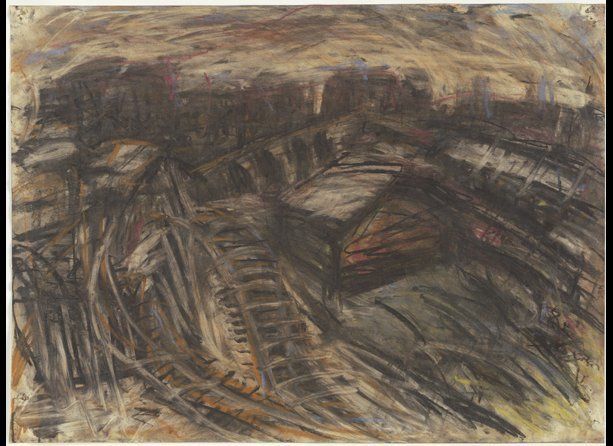Images courtesy of L.A. Louver, Venice, CA
"Why, Sir, you find no man, at all intellectual, who is willing to leave London. No, Sir, when a man is tired of London, he is tired of life; for there is in London all that life can afford."
-- Samuel Johnson
Isolate a square foot (Yes, they're that big), preferably in a corner along the edge of one of Leon Kossoff's paintings in "London Landscapes," his exhibition at L.A. Louver. Forget its subject. See how the massed and sculptural globs of paint seem tocourseandruntogether like the blood, sinew, and muscle from an anatomy lesson scene from one of his beloved Old Masters. An anatomy lesson, indeed: the patient is London, the surgery is as emotional as it is physical, seen here in over 90 paintings and drawings culled from 1952 - 2012.
The fruit of a four-gallery collaboration, this museum quality retrospective of sorts confers us access to many rarely seen drawings. The final stop of a tour that included Annely Juda Fine Art in London, Galerie LeLong in Paris, and Mitchell Innes & Nash in New York, "London Landscapes" asks and then answers the question "What is Kossoff's London like?" The response is, it's gloomy. Until the most recent, relatively effervescent work, the Arnold Circus series, the weather is shades of grey, with a chance of black. It's stormy, energetic, and emphatic. Think of his brushstrokes slashing the canvas and the paper like the animated hand gestures of soapbox orators who used to preach their respective truths in Marble Arch. And it's a city for which Kossoff feels very deeply: the brutal concave and convex lines of the paintings; the furious, mile-a-minute lines of the drawings. London means something to him.
People's expressions are featureless. Kossoff doesn't describe the effect that London has on its citizens; he explains how its citizens are part of the same monumental Parthenon-like frieze. His expressionist style perfectly suits the city's hustle-bustle, its velocity, and, though the general tenor of the work is one of decrepitude, it's portrayed with a spark of vitality, like a postwar Frankenstein London brought miraculously back to life.
Whatever their subject -- Underground stations, church facades, street scenes -- the work resonates majestic, heroic, and symphonic. Kossoff is to cities as Alberto Giacometti is to people. Taut, precarious balances struck between permanence and ephemerality, order and chaos: you get the impression that, engaging so volcanically with his subjects, Kossoff doesn't just seek and capture feeling, he embeds the labor and the product on the canvas, on the paper, the better, for him, to make sense of what he sees around him; and better, for us, historically and psychologically, to have a permanent record of an empire whose sun has set.
The installation is judicious. Entering the room is like walking into a room of sulky adolescents, some bigger than the others, but each shrouded by a tornado of petulance. The exhibition takes up two floors of the Gallery. Downstairs, in the main room, the walls are anchored by the Sturm undDrang large paintings, with the relatively smaller drawings placed to mind the gaps. Some of the wall space is taken up by a series (Train By Night, #2,3, 4 and 5. Think J.M.W. Turner in black and white). The room's effect is staccato, albeit without the brio: it's thumpingly forceful, like a large print out of an EKG. To the left is a small, chapel-like room. The first thing you see is the miraculous sun-drenched though gloomy Christchurch, Spitalfields and you think of Monet and his Rouen Cathedrals.
Upstairs is devoted mostly to Kossoff's recent work, his Arnold Circus pieces. (Note: "circus" in British English means "circle," so Oxford Circus is really a traffic- and pedestrian-clogged intersection, though it is as spectacular as anything from Barnum & Bailey). Here, his touch and mood are decidedly lighter: a pagoda, a mother pushing a pram, a cyclist, and a person on a bench. This work represents a full circle for Kossoff, now 87. Arnold Circus is his childhood home. In his youth, London's East Side was a lot different, a lot like his work downstairs: gritty, unpleasant, and inherently dangerous. Now it's almost gentrified. The exquisite Cherry Tree, Winter, its dynamic diagonal trunk supported by a brace, serves as a nice metaphor for second childhoods: London's, Kossoff's, and ours.
The exhibition is a testament to the literal and emotional weight of paint. Paint as lifeblood. Places, things, and people with density and gravitas that emerge from, are carved into the blunt darkness of the backgrounds. Though not as light-hearted in tone as A.E. Housman's "A Shropshire Lad" poems, Kossoff's work nonetheless bears the same sense of mortal urgency:
"From far, from eve and morning
And yon twelve-winded sky,
The stuff of life to knit me
Blew hither: here am I.
Now - for a breath I tarry
No yet disperse apart -
Take my hand quick and tell me,
What have you in your heart.
Speak now, and I will answer;
How shall I help you, say:
Ere to the wind's twelve quarters
I take my endless way.
The exhibition runs until March 1. Gallery hours are 10am - 6pm, Tuesday - Saturday. The Gallery is located at 45 North Venice Boulevard, CA 90291. For more information, call (310) 822-4955 or visit www.lalouver.com.

